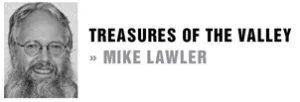The earliest history of the site we know today as the Verdugo Hills Golf Course is shrouded in mystery. It’s the same mystery that cloaks all pre-European human history in the Crescenta Valley. The conspiracy between the culture of the people that lived here (specifically the physical elements of their lives) and the geologic forces that have shaped our Valley has resulted in very little, if any, archeological evidence of their history.
The Tongva Indians that lived here left little behind, having lived lightly on the land. They were semi-nomadic, having a central village, named Wikangna, but also relying heavily on seasonal camps that moved around the Valley as food sources and weather dictated. Their houses were simple light wood structures, easily moved, so their village sites had little impact. And their practice of cremation of their dead left few grave sites to be discovered.
On the geologic front, the burn and flood cycle that even today forms and reshapes our land, ensured that any traces of the village sites has been washed away or buried.
So it’s no surprise that no archeological evidence has been found of Crescenta Valley’s Indian village of Wikangna. We know from Mission records that there were big villages, as I mentioned last week, at Hahamokngna, where JPL is today, and Tujungna, somewhere in Big Tujunga Canyon. But we know there was also one in CV, and that it was associated with La Tuna Canyon. Logically that puts the village at Las Barras Canyon, the name of the small canyon the golf course is situated in. That location had a spring, was well treed with oaks in a lush meadow, and was right next door to the huge oak forests that CV Park is but a remnant of. It was on the established trail (now Honolulu Avenue and Tujunga Canyon Boulevard) between Hahamokngna, Tujungna, and all the villages along the foothills of the San Gabriel Mountains, plus it had easy access to the San Fernando Valley through La Tuna Canyon. It was also slightly elevated out of the flood path of the alluvial fans coming out of the San Gabriels, and it afforded a good view of the entire valley.
In 1771 the Mission at San Gabriel was established, followed by Mission San Fernando. Indians from many of the neighboring villages, including Wikangna, flocked there, attracted by gifts of food, beads and bright cloth – trinkets basically – and by the mission father’s skillful use of ceremonies, music and pageants. However, it wasn’t long before the new converts began to die at alarming rates from disease, abuse, the change in diet patterns and the grueling work demanded of them. Some Indians escaped back to their villages, and were chased by the Mission’s soldiers. The voracious and growing mission system, now losing converts to disease and escapees faster than they could reproduce, began to employ soldiers to round up new “converts” from the local villages. The ones that escaped the net melted into the mountains, and villages like Wikangna lay abandoned.
After the Missions were secularized in 1834, the Mission Indians were cut loose. Now homeless, many drifted into Los Angeles to become part of the degraded work force employed there. Others camped in loose bands in various locations, kept on the move by new landowners. At least a few returned briefly to the site of Wikangna. A young Phil Begue, whose family bought Las Barras Canyon in 1882, wrote that he remembered that there was a band of Indians camped there when his family took possession. They were undoubtedly shooed off the land to drift to another temporary home.
On this site of the Verdugo Hills Golf Course, where people whack golf balls today, was a human history, perhaps thousands of years in length, with its attendant human drama of love, family, religion, and politics. So many fascinating stories unrecorded. It’s all now completely lost, with any traces having been absorbed by the natural forces of the land, and by the hand of development.
Mike Lawler is the president of the Historical Society of the
Crescenta Valley. Reach him at lawlerdad@yahoo.com

